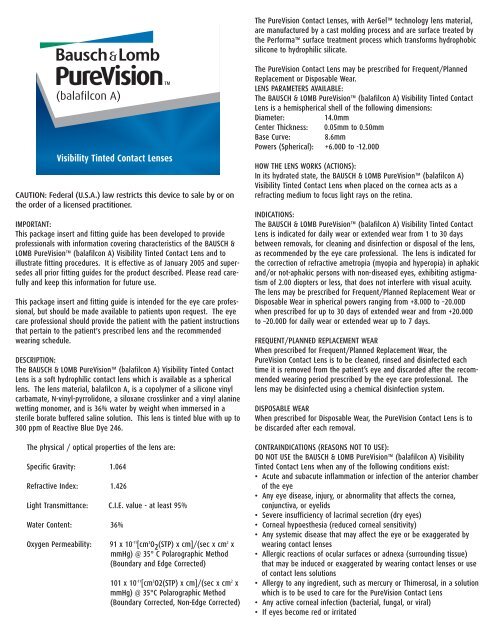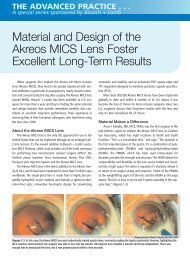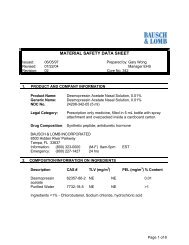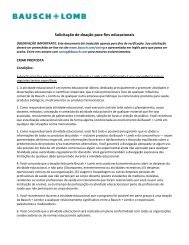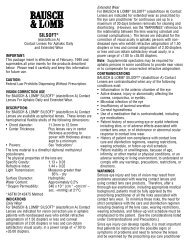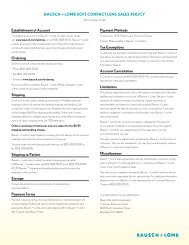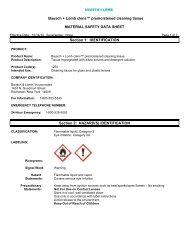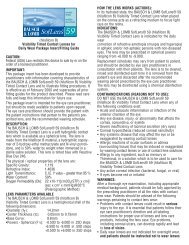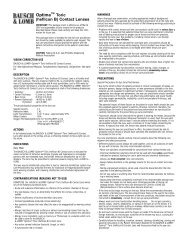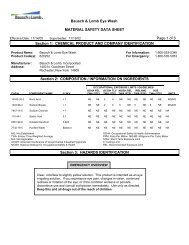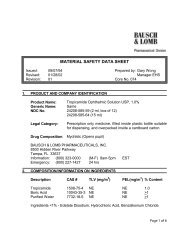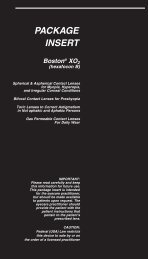BC - Bausch + Lomb
BC - Bausch + Lomb
BC - Bausch + Lomb
Create successful ePaper yourself
Turn your PDF publications into a flip-book with our unique Google optimized e-Paper software.
Visibility Tinted Contact Lenses<br />
CAUTION: Federal (U.S.A.) law restricts this device to sale by or on<br />
the order of a licensed practitioner.<br />
IMPORTANT:<br />
This package insert and fitting guide has been developed to provide<br />
professionals with information covering characteristics of the BAUSCH &<br />
LOMB PureVision (balafilcon A) Visibility Tinted Contact Lens and to<br />
illustrate fitting procedures. It is effective as of January 2005 and supersedes<br />
all prior fitting guides for the product described. Please read carefully<br />
and keep this information for future use.<br />
This package insert and fitting guide is intended for the eye care professional,<br />
but should be made available to patients upon request. The eye<br />
care professional should provide the patient with the patient instructions<br />
that pertain to the patient's prescribed lens and the recommended<br />
wearing schedule.<br />
DESCRIPTION:<br />
The BAUSCH & LOMB PureVision (balafilcon A) Visibility Tinted Contact<br />
Lens is a soft hydrophilic contact lens which is available as a spherical<br />
lens. The lens material, balafilcon A, is a copolymer of a silicone vinyl<br />
carbamate, N-vinyl-pyrrolidone, a siloxane crosslinker and a vinyl alanine<br />
wetting monomer, and is 36% water by weight when immersed in a<br />
sterile borate buffered saline solution. This lens is tinted blue with up to<br />
300 ppm of Reactive Blue Dye 246.<br />
The physical / optical properties of the lens are:<br />
Specific Gravity: 1.064<br />
Refractive Index: 1.426<br />
Light Transmittance: C.I.E. value - at least 95%<br />
Water Content: 36%<br />
Oxygen Permeability: 91 x 10 -11 [cm 3 O 2 (STP) x cm]/(sec x cm 2 x<br />
mmHg) @ 35° C Polarographic Method<br />
(Boundary and Edge Corrected)<br />
101 x 10 -11 [cm 3 O2(STP) x cm]/(sec x cm 2 x<br />
mmHg) @ 35°C Polarographic Method<br />
(Boundary Corrected, Non-Edge Corrected)<br />
The PureVision Contact Lenses, with AerGel technology lens material,<br />
are manufactured by a cast molding process and are surface treated by<br />
the Performa surface treatment process which transforms hydrophobic<br />
silicone to hydrophilic silicate.<br />
The PureVision Contact Lens may be prescribed for Frequent/Planned<br />
Replacement or Disposable Wear.<br />
LENS PARAMETERS AVAILABLE:<br />
The BAUSCH & LOMB PureVision (balafilcon A) Visibility Tinted Contact<br />
Lens is a hemispherical shell of the following dimensions:<br />
Diameter: 14.0mm<br />
Center Thickness: 0.05mm to 0.50mm<br />
Base Curve: 8.6mm<br />
Powers (Spherical): +6.00D to -12.00D<br />
HOW THE LENS WORKS (ACTIONS):<br />
In its hydrated state, the BAUSCH & LOMB PureVision (balafilcon A)<br />
Visibility Tinted Contact Lens when placed on the cornea acts as a<br />
refracting medium to focus light rays on the retina.<br />
INDICATIONS:<br />
The BAUSCH & LOMB PureVision (balafilcon A) Visibility Tinted Contact<br />
Lens is indicated for daily wear or extended wear from 1 to 30 days<br />
between removals, for cleaning and disinfection or disposal of the lens,<br />
as recommended by the eye care professional. The lens is indicated for<br />
the correction of refractive ametropia (myopia and hyperopia) in aphakic<br />
and/or not-aphakic persons with non-diseased eyes, exhibiting astigmatism<br />
of 2.00 diopters or less, that does not interfere with visual acuity.<br />
The lens may be prescribed for Frequent/Planned Replacement Wear or<br />
Disposable Wear in spherical powers ranging from +8.00D to –20.00D<br />
when prescribed for up to 30 days of extended wear and from +20.00D<br />
to –20.00D for daily wear or extended wear up to 7 days.<br />
FREQUENT/PLANNED REPLACEMENT WEAR<br />
When prescribed for Frequent/Planned Replacement Wear, the<br />
PureVision Contact Lens is to be cleaned, rinsed and disinfected each<br />
time it is removed from the patient’s eye and discarded after the recommended<br />
wearing period prescribed by the eye care professional. The<br />
lens may be disinfected using a chemical disinfection system.<br />
DISPOSABLE WEAR<br />
When prescribed for Disposable Wear, the PureVision Contact Lens is to<br />
be discarded after each removal.<br />
CONTRAINDICATIONS (REASONS NOT TO USE):<br />
DO NOT USE the BAUSCH & LOMB PureVision (balafilcon A) Visibility<br />
Tinted Contact Lens when any of the following conditions exist:<br />
• Acute and subacute inflammation or infection of the anterior chamber<br />
of the eye<br />
• Any eye disease, injury, or abnormality that affects the cornea,<br />
conjunctiva, or eyelids<br />
• Severe insufficiency of lacrimal secretion (dry eyes)<br />
• Corneal hypoesthesia (reduced corneal sensitivity)<br />
• Any systemic disease that may affect the eye or be exaggerated by<br />
wearing contact lenses<br />
• Allergic reactions of ocular surfaces or adnexa (surrounding tissue)<br />
that may be induced or exaggerated by wearing contact lenses or use<br />
of contact lens solutions<br />
• Allergy to any ingredient, such as mercury or Thimerosal, in a solution<br />
which is to be used to care for the PureVision Contact Lens<br />
• Any active corneal infection (bacterial, fungal, or viral)<br />
• If eyes become red or irritated
WARNINGS:<br />
After a thorough eye examination, including appropriate medical background,<br />
patients should be fully apprised by the prescribing professional<br />
of all the risks with contact lens wear. Patients should be advised of the<br />
following warnings pertaining to contact lens wear:<br />
• Problems with contact lenses and lens care products could<br />
result in serious injury to the eye. It is essential that patients<br />
follow their eye care professional's direction and all labeling<br />
instructions for proper use of lenses and lens care products,<br />
including the lens case. Eye problems, including corneal<br />
ulcers, can develop rapidly and lead to loss of vision.<br />
• When prescribed for Frequent/Planned Replacement Wear, the<br />
need for strict compliance with the care regimen including<br />
cleaning of the lens case, wearing restrictions, wearing<br />
schedule, and follow-up visit schedule should be emphasized<br />
to the patient.<br />
• Studies have shown that contact lens wearers who are<br />
smokers have a higher incidence of adverse reactions than<br />
nonsmokers.<br />
EXTENDED WEAR<br />
• The risk of microbial keratitis has been shown to be greater among<br />
users of extended wear contact lenses than among users of daily wear<br />
contact lenses. Some researchers believe that these complications are<br />
caused by one or more of the following: a weakening of the cornea's<br />
resistance to infections, particularly during a closed-eye condition, as<br />
a result of hypoxia; an eye environment which is somewhat more conducive<br />
to the growth of bacteria and other microorganisms, particularly<br />
when a regular periodic lens removal and disinfecting or disposal<br />
schedule has not been adhered to by the patient; improper lens disinfection<br />
or cleaning by the patient; contamination of lens care products;<br />
poor personal hygiene by the patient; patient unsuitability to the<br />
particular lens or wearing schedule; accumulation of lens deposits;<br />
damage to the lens; improper fitting; length of wearing time; and the<br />
presence of ocular debris or environmental contaminants.<br />
• While the great majority of patients successfully wear contact lenses,<br />
extended wear of lenses also is reported to be associated with a higher<br />
incidence and degree of epithelial microcycsts and infiltrates, and<br />
endothelial polymegathism, which require consideration of discontinuation<br />
or restriction of extended wear. The epithelial conditions are<br />
reversible upon discontinuation of extended wear.<br />
The long term risk of microbial keratitis has not been determined for<br />
this lens. Post-marketing studies are in progress.<br />
The reversibility of endothelial effects of contact lens’ wear has not<br />
been conclusively established. As a result, professionals views of<br />
extended wearing times vary from not prescribing extended wear at<br />
all to prescribing flexible wearing times from occasional overnight<br />
wear to prescribing extended wearing periods from 1 to 30 days with<br />
specified intervals of no lens wear for certain patients, with follow-up<br />
visits, and with proper care regimen.<br />
• If a patient experiences eye discomfort, excessive tearing, vision<br />
changes, or redness of the eye, the patient should be instructed to<br />
immediately remove lenses and promptly contact his or her eye care<br />
professional.<br />
PRECAUTIONS:<br />
Special Precautions for Eye Care Professionals:<br />
• Due to the small number of patients enrolled in clinical investigation<br />
of lenses, all refractive powers, design configurations, or lens<br />
parameters available in the lens material are not evaluated in significant<br />
numbers.<br />
Consequently, when selecting an appropriate lens design and parameters,<br />
the eye care professional should consider all characteristics of<br />
the lens that can affect lens performance and ocular health, including<br />
oxygen permeability, wettability, central and peripheral thickness, and<br />
optic zone diameter.<br />
The oxygen transmissibility is below the established threshold<br />
required to prevent overnight corneal edema for the extremes of the<br />
power range, above +3.00D and –5.00D. 1 In the U.S. clinical study, the<br />
rate of infiltrative keratitis was found to be higher with higher lens<br />
powers (see Clinical Study section of this package insert).<br />
• The potential impact of these factors on the patient's ocular health<br />
should be carefully weighed against the patient's need for refractive<br />
correction; therefore, the prescribing eye care professional should<br />
carefully monitor the continuing ocular health of the patient and lens<br />
performance on eye.<br />
• Eye care professionals should instruct the patient to REMOVE A LENS<br />
IMMEDIATELY if an eye becomes red or irritated.<br />
• Fluorescein, a yellow dye, should not be used while the lenses are on<br />
the eyes. The lenses absorb this dye and become discolored.<br />
Whenever fluorescein is used in eyes, the eyes should be flushed with<br />
sterile saline solution that is recommended for in-eye use.<br />
• The patient should be instructed to always discard disposable lenses<br />
and lenses worn on a frequent/planned replacement schedule after<br />
the recommended wearing schedule prescribed by the eye care<br />
professional.<br />
• Some patients will not be able to tolerate continuous wear even if<br />
able to tolerate the same or another lens on a daily wear basis. Some<br />
patients who are able to tolerate continuous wear will not be able to<br />
wear their lenses continuously for 30 days. Patients should be carefully<br />
evaluated for continuous wear prior to prescription and dispensing,<br />
and eye care professionals should conduct early and frequent follow-up<br />
examination to determine ocular response to continuous wear.<br />
• As with any contact lens, follow-up visits are necessary to assure the<br />
continuing health of the patient's eyes. The patient should be<br />
instructed as to a recommended follow-up schedule.<br />
• Aphakic patients should not be fitted with PureVision Contact Lenses<br />
until the determination is made that the eye has healed completely.<br />
Eye care professionals should carefully instruct patients about the following<br />
lens care and safety precautions. It is strongly recommended<br />
that patients be provided with a copy of the PureVision Patient<br />
Information Booklet available from BAUSCH & LOMB® and understand its<br />
contents prior to dispensing the lenses.<br />
Handling Precautions:<br />
• Always wash and rinse hands before handling lenses. Do not get cosmetics,<br />
lotions, soaps, creams, deodorants, or sprays in the eyes or on<br />
the lenses. It is best to put on lenses before putting on makeup.<br />
Water-base cosmetics are less likely to damage lenses than oil-base<br />
products.<br />
• Be sure that before leaving the eye care professional's office, the<br />
patient is able to remove lenses promptly or have someone else avail<br />
able to remove them.<br />
• Be certain that the fingers or hands are free of foreign materials<br />
before touching lenses, as microscopic scratches of the lenses may<br />
occur, causing distorted vision and/or injury to the eye.<br />
• Always handle lenses carefully and avoid dropping them.<br />
• Do not touch the lens with fingernails.<br />
1 Holden BA, Mertz GW. Critical Oxygen Levels to Avoid Corneal Edema<br />
for Daily and Extended Wear Contact Lenses. Invest Ophthalmol Vis Sci<br />
25:1162, 1984.
• Carefully follow the handling, insertion, removal, cleaning disinfecting,<br />
storing and wearing instructions in the Patient Information<br />
Booklet for the PureVision Contact Lenses and those prescribed by the<br />
eye care professional.<br />
• Never use tweezers or other tools to remove lenses from the lens<br />
container unless specifically indicated for that use. Pour the lens into<br />
the hand.<br />
Solution Precautions:<br />
Do not use the Allergan Ultracare Disinfecting System or any of its components<br />
(Ultracare Disinfecting Solution, Ultracare Neutralizing Tablets,<br />
Lens Plus Daily Cleaner, and Ultrazyme Enzymatic Cleaner) to clean and<br />
disinfect the PureVision Contact Lens.<br />
• Always use fresh unexpired lens care solutions.<br />
• Always follow directions in the package inserts for the use of contact<br />
lens solutions.<br />
• Sterile unpreserved solutions, when used, should be discarded after<br />
the time specified in the labeling directions.<br />
• Always keep the lenses completely immersed in the recommended<br />
storage solution when lenses are not being worn (stored). Prolonged<br />
periods of drying will damage lenses. Follow the lens care directions<br />
for Care for a Dried Out (Dehydrated) Lens in the patient information<br />
booklet if lens surface does become dried out.<br />
• Do not use saliva or anything other than the recommended solution<br />
for lubricating or wetting lenses.<br />
• Tap water, distilled water or homemade saline should not be used as a<br />
substitute for any component in the lens care regimen since they have<br />
been associated with an Acanthamoeba keratitis infection.<br />
• Never use conventional hard contact lens solutions that are not also<br />
recommended for use with prescribed lenses.<br />
• Do not mix or alternate lens care systems or solutions unless indicated<br />
in the lens care system labeling.<br />
• Do not use chemical disinfection solutions with heat unless specifically<br />
indicated on product labeling for use in both heat and chemical<br />
disinfection.<br />
Lens Wearing Precautions:<br />
• Never wear lenses beyond the period recommended by the eye care<br />
professional.<br />
• If the lens sticks (stops moving) on the eye, follow the recommended<br />
directions on Care for a Sticking Lens. The lens should move freely on<br />
the eye for the continued health of the eye. If nonmovement of the<br />
lens continues, the patient should be instructed to immediately consult<br />
his or her eye care professional.<br />
• Avoid, if possible, all harmful or irritating vapors and fumes while<br />
wearing lenses.<br />
• If aerosol products are used while wearing lenses, exercise caution<br />
and keep eyes closed until the spray has settled.<br />
Lens Case Precautions:<br />
• Contact lens cases can be a source of bacterial growth. To prevent<br />
contamination and to help avoid serious eye injury, always empty and<br />
rinse the lens case with fresh, sterile rinsing solution and allow to air<br />
dry.<br />
• Lens cases should be replaced at regular intervals as recommended by<br />
the lens case manufacturer or eye care professional.<br />
Topics to Discuss with the Patient:<br />
• As with any contact lens, follow-up visits are necessary to assure the<br />
continuing health of the eyes. The patient should be instructed as to<br />
a recommended follow-up schedule.<br />
• Patients should be advised about wearing lenses during sporting and<br />
water related activities. Exposure to water while wearing contact<br />
lenses in activities such as swimming, water skiing and hot tubs may<br />
increase the risk of ocular infection including but not limited to<br />
Acanthamoeba keratitis.<br />
• Always contact the eye care professional before using any medicine in<br />
the eyes.<br />
Who Should Know That the Patient is Wearing Contact Lenses:<br />
• Patients should inform their doctor (health care professional) about<br />
being a contact lens wearer.<br />
• Patients should always inform their employer of being a contact lens<br />
wearer. Some jobs may require the use of eye protection equipment<br />
or may require that you do not wear lenses.<br />
ADVERSE REACTIONS:<br />
The patient should be informed that the following problems may occur:<br />
• Eyes stinging, burning, itching (irritation), or other eye pain<br />
• Comfort is less than when lens was first placed on eye<br />
• Abnormal feeling of something in the eye (foreign body, scratched area)<br />
• Excessive watering (tearing) of the eyes<br />
• Unusual eye secretions<br />
• Redness of the eyes<br />
• Reduced sharpness of vision (poor visual acuity)<br />
• Blurred vision, rainbows, or halos around objects<br />
• Sensitivity to light (photophobia)<br />
• Dry eyes<br />
If the patient notices any of the above, he or she should be instructed<br />
to:<br />
• Immediately remove the lenses.<br />
• If the discomfort or problem stops, then look closely at the lens. If<br />
the lens is in any way damaged, do not put the lens back on the eye.<br />
Place the lens in the storage case and contact the eye care professional.<br />
If the lens has dirt, an eyelash, or other foreign body on it, or the<br />
problem stops and the lens appears undamaged, the patient should<br />
thoroughly clean, rinse, and disinfect the lenses; then reinsert them.<br />
After reinsertion, if the problem continues, the patient should immediately<br />
remove the lenses and consult his or her eye care professional.<br />
If the above symptoms continue after removal of the lens, or upon<br />
reinsertion of a lens, or upon insertion of a new lens, the patient<br />
should immediately remove the lenses and contact his or her eye care<br />
professional or physician, who must determine the need for examination,<br />
treatment or referral without delay. (See Important Treatment<br />
Information for Adverse Reactions.) A serious condition such as infection,<br />
corneal ulcer, corneal vascularization, or iritis may be present,<br />
and may progress rapidly. Less serious reactions such as abrasions,<br />
epithelial staining or bacterial conjunctivitis must be managed and<br />
treated carefully to avoid more serious complications.<br />
Important Treatment Information for Adverse Reactions<br />
Sight-threatening ocular complications associated with contact lens wear<br />
can develop rapidly, and therefore early recognition and treatment of<br />
problems are critical. Infectious corneal ulceration is one of the most<br />
serious potential complications, and may be ambiguous in its early<br />
stage. Signs and symptoms of infectious corneal ulceration include discomfort,<br />
pain, inflammation, purulent discharge, sensitivity to light, cells<br />
and flare, and corneal infiltrates.<br />
Initial symptoms of a minor abrasion and an early infected ulcer are<br />
sometimes similar. Accordingly, such epithelial defect, if not treated<br />
properly, may develop into an infected ulcer. In order to prevent serious<br />
progression of these conditions, a patient presenting symptoms of abrasions<br />
or early ulcers should be evaluated as a potential medical emergency,<br />
treated accordingly, and be referred to a corneal specialist when
appropriate. Standard therapy for corneal abrasions such as eye patching<br />
or the use of steroids or steroid/antibiotic combinations may exacerbate<br />
the condition. If the patient is wearing a contact lens on the<br />
affected eye when examined, the lens should be removed immediately<br />
and the lens and lens care products retained for analysis and culturing.<br />
CLINICAL STUDY:<br />
STUDY DESCRIPTION<br />
Study Design<br />
The objective of this 12-month study was to evaluate the safety and efficacy<br />
of the BAUSCH & LOMB® PureVision (balafilcon A) Visibility Tinted<br />
Contact Lenses worn on a 30-day continuous wear basis, compared to a<br />
conventional Control lens worn on a 7-day continuous wear basis. A<br />
total of 1640 eyes (820 subjects) were enrolled into this study. Subjects<br />
were fitted with a PureVision Contact Lens on one eye while the contralateral<br />
eye was fitted with a Control lens. Subjects were instructed to<br />
replace the PureVision Contact Lens with a new lens every 30 days, and<br />
to wear the Control lens overnight for up to six consecutive nights per<br />
week. Eyes had one night without lens wear after the scheduled<br />
removal. The Control lens was to be replaced with a new lens every 14<br />
days.<br />
Six hundred ten (610) subjects completed the one-year study. Ten subjects<br />
discontinued in the daily wear adaptation period, 182 subjects discontinued<br />
during the extended wear phase and 18 subjects were not dispensed<br />
lenses.<br />
Patient Assessments<br />
Subjects were evaluated at follow-up visits scheduled after 24 hours,<br />
10 days, 1 month, 3 months, 6 months, 9 months, and 12 months of<br />
lens wear.<br />
Demographics<br />
Subject recruitment was open to adapted and unadapted contact lens<br />
wearers. There were no restrictions as to the subject’s gender or occupation,<br />
but subjects were required to be of legal age (typically 18 or 21)<br />
and have the legal capacity to volunteer. The ages of the subjects<br />
ranged from 18 to 74 years of age, with a mean age of 33.6, and included<br />
574 females and 228 males, with a ratio of 2.52 females to every<br />
male. For the PureVision Contact Lens the power range used was –0.50D<br />
to –9.00D. For the Control lens the power range was –0.50D to –8.50D.<br />
The previous lens wearing experience of the subjects that participated in<br />
the study was 5% no lens wear, 43% daily wear, and 51% continuous<br />
wear. The refractive errors of the subjects ranged from –0.25D to<br />
–11.75D, and included up to –2.00D of astigmatism.<br />
SUMMARY OF DATA ANALYSES<br />
Summary of Data Analyses<br />
The key endpoints for this study were:<br />
1. grade 2 and higher slit lamp findings (safety endpoint),<br />
2. grade 2 and higher corneal infiltrates (safety endpoint), and<br />
3. contact lens corrected visual acuity worse than 20/40 (efficacy endpoint).<br />
For each key endpoint, the rates (incidents of endpoint/number of eyes)<br />
experienced by eyes in the PureVision Contact Lens and Control lenses<br />
were calculated. The difference in rates between the two lens types<br />
was determined and a 95% confidence interval for the difference was<br />
calculated. For each key endpoint a "clinically significant difference" in<br />
the rates was established before the study started. These "clinically significant<br />
differences" were as follows: 10% for total slit lamp findings ≥<br />
Grade 2, 5% for corneal infiltrates ≥ Grade 2, and 5% for the acuity endpoint.<br />
For example, if the true rates of endpoint infiltrates in the subject<br />
population were 9.99% in the PureVision Contact Lens and 5% in the<br />
Control lens, these rates would be considered substantially equivalent<br />
(difference
It should be noted that the PureVision Contact Lens and the Control lens<br />
were each fit on only the right or left eye for each subject. Rates per<br />
subject are expected to be higher when lenses are fit on both eyes.<br />
Corneal Infiltrates<br />
The following table describes the rate of corneal infiltrates according to<br />
the lens power used.<br />
Corneal Infiltrates<br />
Lens Power ( ≥ Grade 2)<br />
PureVision Plano to –3.00 1.7%<br />
-3.25 to –6.00 3.2%<br />
>-6.00 6.4%<br />
Total 2.9%<br />
Control Plano to –3.00 0.9%<br />
-3.25 to –6.00 1.5%<br />
>-6.00 1.3%<br />
Total 1.3%<br />
Other Lens-Related Adverse Events<br />
In addition to the outcomes described above, the following lens related<br />
adverse events were noted. This table does not include conjunctivitis or<br />
tarsal conjunctival abnormalities, e.g., giant papillary conjunctivitis.<br />
Other Important Lens-Related Adverse Events<br />
PureVision Control<br />
Corneal Scar 14 (1.8%) 5 (0.6%)<br />
Other Ocular Inflammation* 10 (1.3%) 2 (0.3%)<br />
Anterior Chamber Reaction 2 (0.3%) 1 (0.1%)<br />
Permanent Loss of Vision 0 (0.0%) 0 (0.0%)<br />
*Other Ocular Inflammation includes episcleritis, scleritis, iritis/uveitis.<br />
This condition was reported in association with other conditions such as<br />
keratitis, corneal infiltrates, blepharitis, corneal abrasion, and contact<br />
lens over wear.<br />
It should be noted that the PureVision Contact Lens and Control lenses<br />
were each fit on only the right or left eye for each subject. Rates per<br />
subject are expected to be higher when lenses are fit on both eyes.<br />
Efficacy Outcomes<br />
The contact lens visual acuity was measured at each scheduled and<br />
unscheduled follow-up visit throughout the one-year study. For the 610<br />
subjects that completed the study, visual acuity of 20/20 or better was<br />
reported for 87% and 86% of the measurements for the PureVision<br />
Contact Lens and Control lens, respectively. Similarly, visual acuity of<br />
20/25 or better was reported 98% and 97% of the times for the<br />
PureVision Contact Lens and Control lens.<br />
Wearing Time<br />
In this U.S. clinical study subjects were required to maintain a minimum<br />
wearing time in order to continue in the study. For the subjects that<br />
completed the study, the average continuous wear time for the<br />
PureVision Contact Lens was at least 28.0 days per month, from the 2-<br />
Month visit through the 12-Month visit. At these visits the same subjects<br />
reported they were able to wear the PureVision Contact Lens at least 22<br />
days continuously 94% of the times they were asked.<br />
During the course of the study, 15 subjects were discontinued from the<br />
study because they were not able to wear the PureVision Contact Lens<br />
for 30 days. Twenty-one (21) subjects were discontinued from the study<br />
because they were not able to wear the Control lens for 7 days.<br />
Overnight Corneal Swelling<br />
Two separate studies assessed the corneal swelling response induced by<br />
overnight contact lens wear. In the first study, 30 subjects each wore<br />
either a +3.00D, -3.00D, or –9.00D PureVision Contact Lens and an equivalent<br />
power lens made from a conventional hydrogel material (Control<br />
lens) on the contralateral eye overnight under closed eye conditions for<br />
approximately eight hours. The corneal swelling, measured as the percent<br />
increase in the center thickness of the cornea, with the Control lens<br />
(9.1%) was significantly greater than that measured in conjunction with<br />
the PureVision Contact Lenses (4.1%). In the second study, the corneal<br />
swelling response was measured under similar conditions. In this study<br />
the response to a –3.00D PureVision Contact Lens (3.0%) was compared<br />
to the swelling response to no lens wear (1.9%). The responses were<br />
not statistically different (p-value > 0.05).<br />
SELECTION OF PATIENTS:<br />
The eye care professional should not fit patients who cannot or will not<br />
adhere to a recommended care or replacement regimen, or are unable<br />
to place and remove the lenses should not be provided with them.<br />
Failure to follow handling and cleaning instructions could lead to serious<br />
eye infections which might result in corneal ulcers.<br />
Patient communication is vital because it relates not only to patient<br />
selection but also to ensure compliance. It is also necessary to discuss<br />
the information contained in the Patient Information Booklet with the<br />
patient at the time of the initial examination.<br />
Patients selected to wear PureVision Contact Lenses should be chosen<br />
for their motivation to wear contact lenses, general health and cooperation.<br />
The eye care professional must take care in selecting, examining<br />
and instructing contact lens patients. Patient hygiene and willingness to<br />
follow professional instructions are essential to their success.<br />
A detailed history is crucial to determining patient needs and expectations.<br />
Your patient should be questioned regarding vocation, desired<br />
lens wearing time (full or part time), and desired lens usage (reading,<br />
recreation or hobbies).<br />
Initial evaluation of the trial lens should be preceded by a complete eye<br />
examination, including visual acuity with and without correction at both<br />
distance and near, keratometry and slit lamp examination.<br />
It is normal for the patient to experience mild symptoms such as lens<br />
awareness, variable vision, occasional tearing (watery eyes) and slight<br />
redness during the adaptation period. Although the adaptation period<br />
varies for each individual, generally within one week these symptoms<br />
will disappear. If these symptoms persist, the patient should be<br />
instructed to contact his or her eye care professional.<br />
FITTING PROCEDURE:<br />
1. Pre-Fitting Examination<br />
A pre-fitting patient history and examination are necessary to:<br />
• determine whether a patient is a suitable candidate for contact lenses<br />
(consider patient hygiene and mental and physical state),<br />
• make ocular measurements for initial contact lens parameter selection,<br />
and<br />
• collect and record baseline clinical information to which post-fitting<br />
examination results can be compared.<br />
A prefitting examination should include spherocylinder refraction and VA,<br />
keratometry, and biomicroscopic examination.
2. Initial Lens Power Selection<br />
a. Lens power is determined from the patient’s spherical equivalent<br />
prescription corrected to the corneal plane. Select the appropriate<br />
lensand place on the eye.<br />
b. Allow the lens to remain on the eye long enough (10 to 20 minutes)<br />
to achieve a state of equilibrium. Small variations in the<br />
tonicity, pH of the lens solutions, and individual tear composition<br />
may cause slight changes in fitting characteristics.<br />
c. Allow any increase in tear flow to subside before evaluating the<br />
lens. The time required will vary with the individual.<br />
3. Initial Lens Evaluation<br />
a. To determine proper lens parameters observe the lens relationship<br />
to the eye using a slit lamp.<br />
• Movement: The lens should provide discernible movement with:<br />
– Primary gaze blink<br />
– Upgaze blink<br />
– Upgaze lag<br />
• Centration. The lens should provide full corneal coverage.<br />
b. Lens evaluation allows the contact lens fitter to evaluate the<br />
lens/cornea relationship in the same manner as would be done<br />
with any soft lens. If after the lens has settled on the eye, the<br />
patient reports lens sensation, or if the lens is moving or decentering<br />
excessively, the lens should not be dispensed. Alternatively,<br />
if the patient reports variable vision, or if the lens shows insufficient<br />
movement, the lens should not be dispensed.<br />
4. Criteria of a Well-Fitted Lens<br />
If the initial lens selection fully covers the cornea, provides discernible<br />
movement after a blink, is comfortable for the patient and<br />
provides satisfactory visual performance, it is a well fitted lens and<br />
can be dispensed.<br />
5. Characteristics of a Tight (Steep) Lens<br />
A lens which is much too steep may subjectively and objectively<br />
cause distortion which will vary after a blink. However, if a lens is<br />
only marginally steep, the initial subjective and objective vision and<br />
comfort findings may be quite good. A marginally steep lens may be<br />
differentiated from a properly fitted lens by having the patient gaze<br />
upward. A properly fitted lens will tend to slide downward approximately<br />
0.5mm while a steep lens will remain relatively stable in relationship<br />
to the cornea, particularly with the blink.<br />
6. Characteristics of a Loose (Flat) Lens<br />
If the lens is too flat, it will:<br />
– Decenter, especially on post-blink.<br />
– Have a tendency to edge lift inferiorly and sit on the lower lid,<br />
rather than positioning between the sclera and palpebral conjunctiva.<br />
– Have a tendency to be uncomfortable and irritating with fluctuating<br />
vision.<br />
– Have a tendency to drop or lag greater than 2.0mm on upgaze<br />
post-blink.<br />
7. Follow-up Care<br />
a. Follow-up examinations are necessary to ensure continued successful<br />
contact lens wear. From the day of dispensing, the following<br />
schedule is a suggested guideline for follow up.<br />
• 24 hours<br />
• 10 days<br />
• 1 month<br />
• 3 months<br />
• every six months thereafter<br />
At the initial follow-up evaluations the eye care professional should<br />
again reassure the patient that any of the previously described<br />
adaptive symptoms are normal, and that the adaptation period<br />
should be relatively brief. Depending on the patient's prior experience<br />
with contact lenses and/or continuous wear, the eye care<br />
professional may consider prescribing a one week period of daily<br />
wear adaptation prior to beginning continuous wear.<br />
b. Prior to a follow-up examination, the contact lenses should be worn<br />
for at least 4 continuous hours and the patient should be asked to<br />
identify any problems which might be occurring related to contact<br />
lens wear. If the patient is wearing the lenses for continuous wear,<br />
the follow-up examination should be conducted as early as possible<br />
the morning after overnight wear.<br />
c. With lenses in place on the eyes, evaluate fitting performance to<br />
assure that CRITERIA OF A WELL FITTED LENS continue to be satisfied.<br />
Examine the lenses closely for surface deposition and/or damage.<br />
d. After the lens removal, instill sodium fluorescein [unless<br />
contraindicated] into the eyes and conduct a thorough biomicroscopy<br />
examination.<br />
1. The presence of vertical corneal striae in the posterior central<br />
cornea and/or corneal neovascularization may be indicative of<br />
excessive corneal edema.<br />
2. The presence of corneal staining and/or limbal-conjunctival<br />
hyperemia can be indicative of an unclean lens, a reaction to<br />
solution preservatives, excessive lens wear, and/or a poorly<br />
fitting lens.<br />
3. Papillary conjunctival changes may be indicative of an unclean<br />
and/or damaged lens.<br />
If any of the above observations are judged abnormal, various<br />
professional judgments are necessary to alleviate the problem<br />
and restore the eye to optimal conditions. If the CRITERIA OF A<br />
WELL FITTED LENS are not satisfied during any follow-up examination,<br />
the patient should be re-fitted with a more appropriate<br />
lens.<br />
PROFESSIONAL FITTING SETS:<br />
Lenses must be discarded after a single use and must not be used from<br />
patient to patient.<br />
WEARING SCHEDULE:<br />
The wearing and replacement schedules should be determined by the<br />
eye care professional. Regular checkups, as determined by the eye care<br />
professional, are extremely important.<br />
Daily Wear:<br />
There may be a tendency for the daily wear patient to over wear the<br />
lenses initially. Therefore, the importance of adhering to a proper, initial<br />
daily wearing schedule should be stressed to these patients. The wearing<br />
schedule should be determined by the eye care professional. The<br />
wearing schedule chosen by the eye care professional should be provided<br />
to the patient.<br />
Continuous Wear (Greater than 24 hours or while asleep):<br />
The wearing schedule should be determined by the prescribing eye care<br />
professional for each individual patient, based upon a full examination<br />
and patient history as well as the professional's experience and professional<br />
judgment. <strong>Bausch</strong> & <strong>Lomb</strong> recommends beginning continuous<br />
wear patients with the recommended initial daily wear schedule, followed<br />
by a period of daily wear, and then gradual introduction of continuous<br />
wear one night at a time, unless individual considerations indicate<br />
otherwise. The professional should examine the patient in the early<br />
stages of continuous wear to determine the corneal response. The lens<br />
must be removed, cleaned and disinfected or disposed of and replaced<br />
with a new lens, as determined by the prescribing eye care professional.<br />
(See the factors discussed in the Warnings section.) Once removed, a<br />
lens should remain out of the eye for a period of rest overnight or<br />
longer, as determined by the prescribing eye care professional.
MONOVISION FITTING GUIDELINES:<br />
1. Patient Selection<br />
A. Monovision Needs Assessment<br />
For a good prognosis the patient should have adequately corrected<br />
distance and near visual acuity in each eye. The amblyopic<br />
patient or the patient with significant astigmatism (greater than<br />
one [1] diopter) in one eye may not be a good candidate for<br />
monovision with the BAUSCH & LOMB® PureVision (balafilcon A)<br />
Visibility Tinted Contact Lenses.<br />
Occupational and environmental visual demands should be<br />
considered. If the patient requires critical vision (visual acuity and<br />
stereopsis) it should be determined by trial whether this patient<br />
can function adequately with monovision. Monovision contact lens<br />
wear may not be optimal for such activities as:<br />
(1) visually demanding situations such as operating potentially<br />
dangerous machinery or performing other potentially hazardous<br />
activities; and<br />
(2) driving automobiles (e.g., driving at night). Patients who<br />
cannot pass their state drivers license requirements with<br />
monovision correction should be advised to not drive with this<br />
correction, OR may require that additional over-correction be<br />
prescribed.<br />
B. Patient Education<br />
All patients do not function equally well with monovision correction.<br />
Patients may not perform as well for certain tasks with this<br />
correction as they have with bifocal reading glasses. Each patient<br />
should understand that monovision can create a vision compromise<br />
that may reduce visual acuity and depth perception for distance<br />
and near tasks. During the fitting process it is necessary for the<br />
patient to realize the disadvantages as well as the advantages of<br />
clear near vision in straight ahead and upward gaze that monovision<br />
contact lenses provide.<br />
2. Eye Selection<br />
A. Ocular Preference Determination Methods<br />
Generally, the non-dominant eye is corrected for near vision. The<br />
following test for eye dominance can be used.<br />
Method 1 - Determine which eye is the "sighting dominant eye."<br />
Have the patient point to an object at the far end of the room.<br />
Cover one eye. If the patient is still pointing directly at the object,<br />
the eye being used is the dominant (sighting) eye.<br />
Method 2 - Determine which eye will accept the added power with<br />
the least reduction in vision. Place a trial spectacle near add lens<br />
in front of one eye and then the other while the distance refractive<br />
error correction is in place for both eyes. Determine whether<br />
the patient functions best with the near add lens over the right or<br />
left eye.<br />
B. Refractive Error Method<br />
For anisometropic corrections, it is generally best to fit the more<br />
hyperopic (less myopic) eye for distance and the more myopic<br />
(less hyperopic) eye for near.<br />
C. Visual Demands Method<br />
Consider the patient's occupation during the eye selection process<br />
to determine the critical vision requirements. If a patient's gaze<br />
for near tasks is usually in one direction correct the eye on that<br />
side for near.<br />
Example:<br />
A secretary who places copy to the left side of the desk will usually<br />
function best with the near lens on the left eye.<br />
3. Special Fitting Considerations<br />
Unilateral Lens Correction<br />
There are circumstances where only one contact lens is required. As<br />
an example, an emmetropic patient would only require a near lens<br />
while a bilateral myope may require only a distance lens.<br />
Example:<br />
A presbyopic emmetropic patient who requires a +1.75 diopter add<br />
would have a +1.75 lens on the near eye and the other eye left<br />
without a lens.<br />
A presbyopic patient requiring a +1.50 diopter add who is -2.50<br />
diopters myopic in the right eye and -1.50 diopters myopic in the<br />
left eye may have the right eye corrected for distance and the left<br />
uncorrected for near.<br />
4. Near Add Determination<br />
Always prescribe the lens power for the near eye that provides optimal<br />
near acuity at the midpoint of the patient's habitual reading distance.<br />
However, when more than one power provides optimal reading performance,<br />
prescribe the least plus (most minus) of the powers.<br />
5. Trial Lens Fitting<br />
A trial fitting is performed in the office to allow the patient to experience<br />
monovision correction. Lenses are fit according to the directions<br />
in the general fitting guidelines.<br />
Case history and standard clinical evaluation procedure should be<br />
used to determine the prognosis. Determine which eye is to be corrected<br />
for distance and which eye is to be corrected for near. Next<br />
determine the near add. With trial lenses of the proper power in<br />
place observe the reaction to this mode of correction.<br />
Immediately after the correct power lenses are in place, walk across<br />
the room and have the patient look at you. Assess the patient's reaction<br />
to distance vision under these circumstances. Then have the<br />
patient look at familiar near objects such as a watch face or fingernails.<br />
Again assess the reaction. As the patient continues to look<br />
around the room at both near and distance objects, observe the reactions.<br />
Only after these vision tasks are completed should the patient<br />
be asked to read print. Evaluate the patient's reaction to large print<br />
(e.g. typewritten copy) at first and then graduate to newsprint and<br />
finally smaller type sizes.<br />
After the patient's performance under the above conditions are completed,<br />
tests of visual acuity and reading ability under conditions of<br />
moderately dim illumination should be attempted.<br />
An initial unfavorable response in the office, while indicative of a<br />
guarded prognosis, should not immediately rule out a more extensive<br />
trial under the usual conditions in which a patient functions.<br />
6. Adaptation<br />
Visually demanding situations should be avoided during the initial<br />
wearing period. A patient may at first experience some mild blurred<br />
vision, dizziness, headaches, and a feeling of slight imbalance. You<br />
should explain the adaptational symptoms to the patient. These<br />
symptoms may last for a brief minute or for several weeks. The<br />
longer these symptoms persist, the poorer the prognosis for successful<br />
adaptation.<br />
To help in the adaptation process the patient can be advised to first<br />
use the lenses in a comfortable familiar environment such as in the<br />
home. Some patients feel that automobile driving performance may<br />
not be optimal during the adaptation process. This is particularly true<br />
when driving at night. Before driving a motor vehicle, it may be recommended<br />
that the patient be a passenger first to make sure that<br />
their vision is satisfactory for operating an automobile. During the<br />
first several weeks of wear (when adaptation is occurring), it may be<br />
advisable for the patient to only drive during optimal driving conditions.<br />
After adaptation and success with these activities, the patient<br />
should be able to drive under other conditions with caution.<br />
7. Other Suggestions<br />
The success of the monovision technique may be further improved by<br />
having your patient follow the suggestions below.<br />
– Having a third contact lens (distance power) to use when critical<br />
distance viewing is needed.
– Having a third contact lens (near power) to use when critical near<br />
viewing is needed.<br />
– Having supplemental spectacles to wear over the monovision contact<br />
lenses for specific visual tasks may improve the success of monovision<br />
correction. This is particularly applicable for those patients<br />
who cannot meet state licensing requirements with a monovision<br />
correction.<br />
– Make use of proper illumination when carrying out visual tasks.<br />
Success in fitting monovision can be improved by the following<br />
suggestions.<br />
– Reverse the distance and near eyes if a patient is having trouble<br />
adapting.<br />
– Refine the lens powers if there is trouble with adaptation. Accurate<br />
lens power is critical for presbyopic patients.<br />
– Emphasize the benefits of the clear near vision in straight ahead<br />
and upward gaze with monovision.<br />
* The decision to fit a patient with a monovision correction is most<br />
appropriately left to the eye care professional in conjunction with<br />
the patient after carefully considering the patient's needs.<br />
* All patients should be supplied with a copy of the PureVision<br />
Contact Lens Patient Information Booklet.<br />
HANDLING OF LENSES<br />
Patient Lens Care Directions:<br />
When lenses are dispensed, the patient should be provided with appropriate<br />
and adequate instructions and warnings for lens care handling.<br />
The eye care professional should recommend appropriate and adequate<br />
procedures and products for each individual patient in accordance with<br />
the particular lens wearing schedule and care system selected by the<br />
professional, the specific instructions for such products and the particular<br />
characteristics of the patient.<br />
Frequent/Planned Replacement Wear: For complete information concerning<br />
the care, cleaning and disinfection of contact lenses refer to the<br />
PureVision (balafilcon A) Visibility Tinted Contact Lens Patient<br />
Information Booklet.<br />
Disposable Wear: For complete information concerning emergency lens<br />
care, refer to the PureVision Contact Lens Patient Information Booklet.<br />
CARE FOR A STICKING (NONMOVING) LENS:<br />
If the lens sticks (stops moving), the patient should be instructed to use<br />
a lubricating or rewetting solution in their eye. The patient should be<br />
instructed to not use plain water, or anything other than the recommended<br />
solutions. The patient should be instructed to contact the eye<br />
care professional if the lens does not begin to move upon blinking after<br />
several applications of the solution, and to not attempt to remove the<br />
lens except on the advice of the eye care professional.<br />
REPORTING OF ADVERSE REACTIONS:<br />
All serious adverse experiences and adverse reactions observed in<br />
patients wearing BAUSCH & LOMB® PureVision (balafilcon A) Visibility<br />
Tinted Contact Lenses or experienced with the lenses should be reported<br />
to:<br />
<strong>Bausch</strong> & <strong>Lomb</strong> Incorporated<br />
Rochester, New York 14609<br />
Toll Free Telephone Number<br />
In the Continental U.S., Alaska, Hawaii<br />
1-800-828-9030<br />
In New York State In Canada<br />
1-800-462-1720 1-888-459-5000<br />
HOW SUPPLIED:<br />
Each sterile lens is supplied in a plastic blister package containing borate<br />
buffered saline solution. The container is marked with the manufacturing<br />
lot number of the lens, the base curve, sphere, diameter and expiration<br />
date. Store lenses at room temperature (60°F - 80°F, 15°C - 25°C)<br />
<strong>Bausch</strong> & <strong>Lomb</strong> Incorporated<br />
Rochester, NY 14609<br />
© <strong>Bausch</strong> & <strong>Lomb</strong> Incorporated.<br />
All rights reserved worldwide.<br />
<strong>Bausch</strong> & <strong>Lomb</strong>, Path Design, Performa, AerGel and PureVision are trademarks<br />
of <strong>Bausch</strong> & <strong>Lomb</strong> Incorporated.<br />
Other brand names/product names are trademarks of their<br />
respective owners<br />
Covered by and/or licensed under one or more of the following US<br />
patents: 5610252, 4997897, 5815239, 5760100; 5789461; 5849811;<br />
5766999; 5965631 and other patents.<br />
Printed in U.S.A.<br />
Symbol Reference Guide for label and cartons:<br />
STERILE<br />
LOT<br />
Quality System Certification Symbol<br />
Fee Paid for Waste Management<br />
Sterile Using Steam or Dry Heat<br />
See Instruction Leaflet<br />
Storage Temperature<br />
Diameter<br />
Use By Date (expiration date)<br />
Batch Code<br />
EC REP<br />
Diopter (lens power)<br />
Authorized representative in European Community<br />
Caution: Federal law restricts this device to sale by or on<br />
the order of a licensed professional.<br />
<strong>BC</strong> Base Curve<br />
800202W


